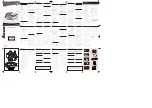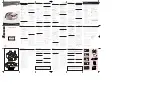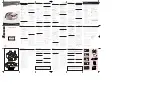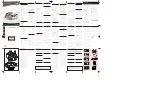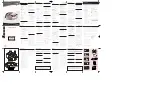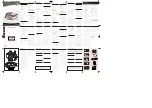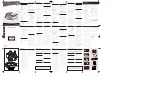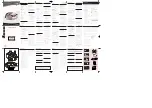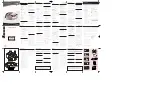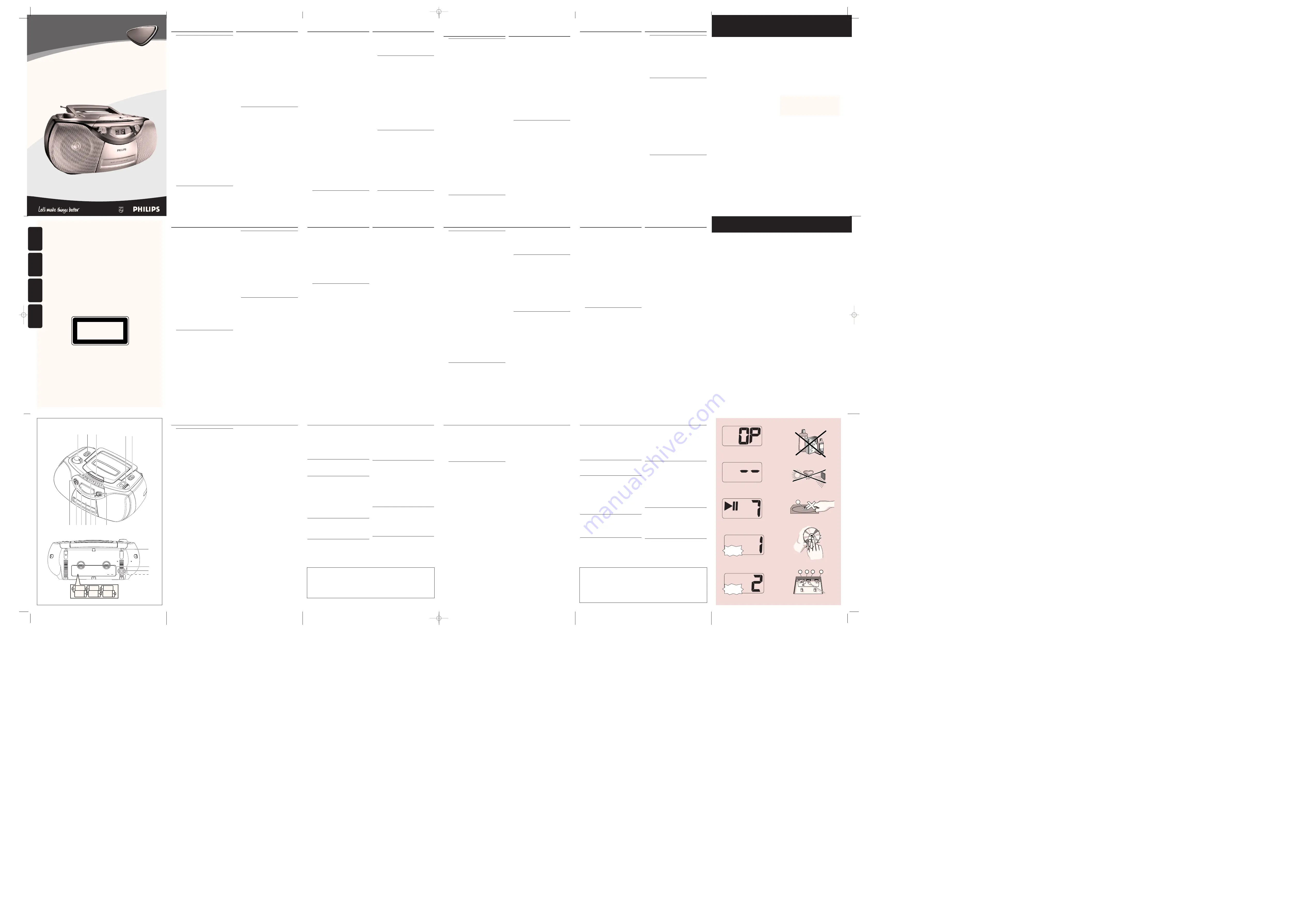
Precautions & General
Maintenance (See
7
)
•
Place the set on a hard and flat surface so
that the system does not tilt.
•
Do not expose the set, batteries, CDs to
humidity, rain, sand or excessive heat caused
by heating equipment or direct sunlight.
•
Do not cover the set. Adequate ventilation
with a minimum gap of 6 inches between the
ventilation holes and surrounding surfaces is
necessary to prevent heat build-up.
•
The mechanical parts of the set contain
self-lubricating bearings and must not be oiled
or lubricated.
•
To clean the set, use a dry cloth. Do not use
any cleaning agents containing alcohol,
ammonia, benzene or abrasives as these may
harm the housing.
Tape deck maintenance (See
7
)
To ensure quality recording and playback of
the tape deck, clean parts
A
,
B
and
C
as
shown, once a month. Use a cotton bud
slightly moistened with alcohol or a special
head cleaning fluid to clean the deck.
1
Open the cassette holder by pressing
9/
.
2
Press
2
and clean the roller
C
.
3
Press
;
and clean the heads
A
, and the
capstan
B
.
4
After cleaning, press
9
.
➜
Cleaning of the heads can also be done by
playing a cleaning cassette through once.
CD player and CD handling (See
7
)
•
If the CD player cannot read CDs correctly,
use a cleaning CD to clean the lens before
taking the set to repair.
•
The lens of the CD player should never be
touched!
•
Sudden changes in the surrounding
temperature can cause condensation on the
lens of your CD player. Playing a CD is then
not possible. Do not attempt to clean the
lens but leave the set in a warm environment
until the moisture evaporates.
•
Always close the CD-tape door to avoid dust
on the lens.
•
To clean the CD, wipe in a straight line from
the center towards the edge using a soft,
lint-free cloth. Do not use cleaning agents as
they may damage the disc.
•
Never write on a CD or attach any stickers
to it.
Problem
–
Possible cause
• Remedy
No sound /power
–
Volume not adjusted
• Adjust the VOLUME
–
Power cord not securely connected
• Connect the AC power cord properly
–
Batteries dead/ incorrectly inserted
• Insert (fresh) batteries correctly
Display does not function properly/ No
reaction to operation of any of the con-
trols
–
Electrostatic discharge
• Switch off and unplug the set. Reconnect after a
few seconds
The CD skips tracks
–
CD damaged or dirty
• Replace or clean CD
–
Program is active
• Quit program mode
--
indication
–
No CD inserted
• Insert a CD
–
CD badly scratched or dirty
• Replace/ clean CD, see Maintenance
–
Laser lens steamed up
• Wait until lens has cleared
–
CD-R is blank or not finalized/ CD-RW inserted
• Use a finalized CD-R or suitable CD Audio disc
only
Poor cassette sound quality
–
Dust and dirt on the heads, etc.
• Clean deck parts, see Maintenance
–
Use of incompatible cassette types (METAL or
CHROME)
• Only use NORMAL (IEC I) for recording
Recording does not work
–
Cassette tab(s) may be broken
• Apply adhesive tape over the missing tab space
et insérez une cassette. Refermez la platine à
cassettes.
4
Appuyez sur
0
pour démarrer l'enregistrement.
5
Pour interrompre brièvement l'enregistrement,
appuyez sur
;
. Pour reprendre l'enreg-
istrement; appuyez à nouveau sur
;
.
6
Pour arrêter l'enregistrement, appuyez sur
9/
.
Précautions & Entretien
Général (Voir
7
)
•
Placez l’équipement sur une surface plane et
dure de sorte que le système ne soit pas dis-
posé sous un certain angle.
•
N’exposez jamais l’équipement, les piles, les
CD à l’humidité, à la pluie, au sable ni à une
chaleur excessive due à la production de
chaleur propre à l’équipement ou à l’exposition
directe aux rayons du soleil.
•
Ne pas recouvrir l’équipement. Une ventila-
tion adéquate d’au moins 15 cm entre les
orifices de ventilation et les surfaces est
nécessaire pour éviter la montée en chaleur.
•
Les pièces mécaniques de l’équipement conti-
ennent des paliers autolubrifiants et ne
requièrent donc aucun huilage ni lubrification.
•
Vous pouvez nettoyer l’équipement avec une
peau de chamois douce et sèche. Ne jamais
utiliser de détergents contenant de l’alcool, de
l’ammoniaque, du benzène ou des abrasifs, car
ceux-ci peuvent endommager le boîtier.
Entretien de la platine cassette
(Voir
7
)
Pour assurer la bonne qualité de l'enreg-
istrement et de la lecture de l'enregistreur
cassette, nettoyez les parties
A
,
B
et
C
indiquées dans le schéma ci-dessous après
environ 50 heures de service ou en moyenne
une fois par mois. Pour ce faire, utilisez un
coton-tige humecté d'alcool ou un liquide de
nettoyage spécial pour les deux cassettes.
1
Ouvrez le compartiment cassette en
appuyant sur
9/
.
2
Appuyez sur
2
et nettoyez les galets
presseurs en caoutchouc
C
.
3
Appuyez sur
;
et nettoyez les têtes magné-
tiques
A
et le cabestan
B
.
4
Après le nettoyage, appuyez sur
9
.
➜
Le nettoyage des têtes peut également se
faire en faisant tourner une fois une cas-
sette de nettoyage.
Entretien du lecteur de CD et des CD
(Voir
7
)
•
Si le lecteur de CD ne lit pas correctement
les CD, utilisez un CD de nettoyage en vente
dans le commerce, pour nettoyer la lentille
avant d'emmener votre équipement chez le
réparateur. D'autres méthodes de nettoyage
pourraient abîmer la lentille.
•
Ne jamais toucher à la lentille du lecteur de CD!
•
Des changements soudains de température
ambiante peuvent entraîner la condensation
et donc agir sur la lentille de votre lecteur de
CD. Dans ce cas, la lecture n'est pas possible.
N'essayez pas de nettoyer la lentille, mais lais-
sez l'équipement s'adapter à la température
ambiante, de sorte que toute l'humidité ait le
temps de s'évaporer.
•
Pour nettoyer le CD, frottez en ligne droite
en partant du centre vers le bord avec un
chiffon doux non pelucheux. L'emploi d'un
détergent peut endommager le CD.
•
Ne faites jamais d'inscription sur le CD et
n'apposez jamais d'autocollants.
Probleme
–
Cause possible
• Remede
Pas de tonalité/puissance
–
VOLUME non réglé
• Réglez le VOLUME
–
Cordon d'alimentation mal branché
• Branchez correctement le cordon d'alimentation
–
Piles à plat/ incorrectment insérées.
• Insérez denouvelles piles correctment
L’affichage ne fonctionne pas adéquatement/
aucune réaction à l’agissement sur l’une des
commandes
–
Décharge électrostatique
• Mettez l’équipement hors service et débranchez la
fiche secteur. Rebranchez au bout de quelques
secondes
Le CD saute des plages
–
CD endommagé ou contaminé
• Remplacez ou nettoyez le CD
–
Un programme a été activé
• Désactivez le mode de programmation
Indication
--
–
Pas de CD dans l’appareil
• Insérez un CD
–
CD griffé/contaminé
• Remplacez ou nettoyez le CD, voir Entretien
–
Lentille laser embuée
• Attendez jusqu'à ce que la lentille soit claire
–
Le CD-R (CD Enregistrable) est vierge ou non-finalisé
/ CD-RW (CD Réécrivable) inséré
• Utilisez un CD-R finalisé ou un CD audio
approprié uniquement
Mauvaise qualité de son cassette
–
Têtes contaminées ou sales, etc.
• Nettoyez les parties de platine, voir Entretien
–
Utilisation de types de cassettes incompatibles
(METAL ou CHROME)
• Utilisez uniquement des cassettes NORMAL (IEC
I) pour l'enregistrement
L'enregistrement ne fonctionne pas
–
Ergot(s) de cassette rompu(s)
• Appliquez un morceau de bande adhésivepour
recouvrir l'ouverture
Top and front panels (See
1
)
1
VOLUME
– to adjust volume level
2
Source selector
:
CD,TUNER,
TAPE/
POWER OFF
– selects CD, tuner or tape source of sound
– power off switch
3
CD door
4
TUNING
– tunes to radio stations
5
BAND
– selects waveband
6
PREVIOUS, NEXT
∞
,
§
– skips or searches a passage/track
backwards or forward
7
PROG
– programs and reviews
programmed track numbers
8
CASSETTE RECORDER keys:
;
– pauses playback or recording
9/
– stops the tape;
– opens the cassette holder
5
or
6
– fast rewinds/ winds tape
2
– starts playback
0
– starts recording
9
Cassette door
0
CD Display
– shows the CD functions
!
PLAY/PAUSE
2;
- starts or pauses CD
playback.
@
STOP
9
– stop playback;
– erases a CD program.
Back panel
#
Telescopic antenna
- improves FM
reception.
Note: AM band antenna is built into set
(see Tuner reception)
$
Battery door
- open to insert 6 x 1.5V
R-14
/
UM2
/
C-cells
.
%
AC POWER/MAINS
- inlet for power
cord.
^
Voltage selector
– (inside the battery
compartment, not all versions) adjust to
match the local voltage 110/220V before
plugging in the set.
CAUTION
Use of controls or adjustments or
performance of procedures other
than herein may result in hazardous
radiation exposure or other unsafe
operation.
Power Supply
Whenever convenient, use the mains supply
cord if you want to conserve battery life.
Make sure you remove the plug from the set
and wall outlet before inserting batteries.
Batteries (not included)
1
Open the battery compartment and insert
six batteries, type
R-14
,
UM-2
or
C-cells
,
(preferably alkaline) with the correct polarity
as indicated by the "
+
" and "
–
" symbols inside
the compartment. (See
1
)
2
Replace the compartment door, making sure
the batteries are firmly and correctly in place.
The set is now ready to operate.
Batteries contain chemical substances, so
they should be disposed of properly.
Incorrect use of batteries can cause
electrolyte leakage and will corrode the
compartment or cause the batteries to burst:
• Do not mix battery types: e.g. alkaline with
carbon zinc. Only use batteries of the same
type for the set.
• When inserting new batteries, do not try to
mix old batteries with the new ones.
• Remove the batteries if the set is not to be
used for a long time.
Using AC Mains
1
Check if the power/mains voltage,
as shown
on the type plate located on the
bottom of the set,
corresponds to your
local power supply. If it does not, consult your
dealer or service center.
2
Connect the power cord to the AC
POWER/MAINS inlet and the wall socket.The
mains lead is now connected and ready for
use.
3
To switch the set off completely, withdraw the
power cord from the wall socket.
•
Disconnect the mains lead from the wall
socket to protect your set during heavy
thunderstorms.
The type plate is located on the bottom
of the set.
Switching POWER on/off:
Save energy
To avoid unnecessary energy consumption,
always adjust the
source selector
to
TAPE/
POWER OFF
after using the set. Also
check that the tape deck keys are released.
General operation
1
To select your sound source adjust the
source selector
to :
CD
,
TUNER
or
TAPE/
POWER OFF
.
2
Adjust the sound with the
VOLUME
control.
3
To switch off the set, adjust the source
selector to
TAPE/
POWER OFF
position and
check the cassette keys are released.
Tuner reception
1
Adjust the
source selector
to
TUNER
.
2
Adjust
BAND
to select your desired wave-
band.
3
Turn
TUNING
to tune to a station.
•
For
FM
band signals, extend and turn the
telescopic antenna for best reception. Reduce
its length if the signal is too strong.
•
For
MW (AM)
band signals, the set uses a
built-in antenna. Direct this antenna for best
reception by turning the whole set.
4
To switch off the radio, adjust the source
selector to
TAPE/
POWER OFF
position and
check the cassette keys are released.
CD Player
Display indication for CD functions:
–
OP
: (See
2
) CD door open
–
--
: (See
3
) reading disc contents / no
disc/ error in CD operation or CD/ CD-
R is blank or not finalized (see
Troubleshooting)
–
During CD playback
:
2
and current
track number
–
2;
: (See
4
) playback on pause
–
prog
: when CD program is active
–
Fu
: program memory full
Playing a CD
This CD player plays Audio Discs
including CD-Recordables.
Anneaux supérieur et avant
(Voir
1
)
1
VOLUME
3
,
4
- réglage du niveau de volume.
2
Sélecteur de source
:
CD,TUNER,
TAPE/
POWER OFF
– sélectionne la source de son CD, la radio
ou la source de son cassette
– mise en/ hors service
3
Platine à CD
4
TUNING
– réglage des émetteurs radio
5
BAND
- sélection des longueurs d'onde.
6
PREVIOUS, NEXT
∞
,
§
– saut ou recherche d’un passage/d’une plage
en marche arrière ou en marche avant
7
PROG
– programmation des plages et
passage en revue des morceaux programmés
8
Touches de la PLATINE DE CASSETTE:
;
– pour interrompre l’enregistrement ou la lecture
9/
– arrêt de lecture;
– l'enregistrement des cassettes
5
ou
6
– pour bobinage/rebobinage rapide
des cassettes
2
– démarre la lecture
0
– démarre l'enregistrement.
9
Platine à Cassettes
0
Affichage
- indique le mode actuel de
l'équipement
!
PLAY/PAUSE
2;
- démarrage ou
interruption de lecture CD
@
STOP
9
– arrêt de lecture ou effacement d'un
programme
Panneaux Arrière
#
Antenne télescopique
- améliore la
réception FM.
Remarque: Pour AM, l'équipement est
pourvu d'une antenne intégrée (Voir
Réception radio)
$
Clapet de compartiment piles
- pour 6
piles, type
R-14
,
UM2
ou
C-cells
.
%
AC MAINS
- entrée pour cordon
d'alimentation.
^
Sélecteur de tension
– (à l'intérieur du
compartiment à piles, pour certaines versions
uniquement) pour ajuster la tension d'entrée
à la tension de votre localité 110/220V avant
de brancher l'appareil.
ATTENTION
L’utilisation des commandes ou
réglages ou le non respect des
procédures ci-incluses peuvent se
traduire par une exposition dan-
gereuse à l’irradiation.
Alimentation secteur
Si possible, utilisez l'alimentation secteur pour
garantir la longévité des piles. Assurez-vous
toujours d'avoir débranché la fiche de
l'équipement et de la prise murale avant
d'introduire les piles.
Piles (non comprises)
1
Ouvrez le compartiment piles et introduisez
les six piles,type
R-14
,
UM-2
ou
cellules C
,
(de préférence alcaline) de polarité correcte
indiquée par les symboles "
+
" et "
–
" à
l'intérieur du compartiment (Voir
1
).
2
Refermez le compartiment de piles, après
s'être assuré que les piles soient fermement
et correctement en place. L'équipement
estalors prêt à l'emploi.
Les piles contiennent des substances chim-
iques et doivent donc être traitées comme
des déchets spéciaux.
L'emploi incorrect des piles peut causer des
fuites électrolytiques et ce faisant, contaminer
le compartiment ou causer l'éclatement des
dites piles. Pour ce faire, procédez comme suit:
• Ne jamais utiliser des types de piles différents:
par exemple alcalines et des «zinc carbone».
Utilisez uniquement des piles dumême type
pour l'équipement.
• Lorsque vous insérez des nouvelles piles,
n'utilisez jamais des anciennes piles avec des
nouvelles.
• Enlevez les piles si l'équipement n'est pas utilisé
pendant une période prolongée.
Utilisation de l’alimentation ácourant
alternatif
1
Contrôlez si la tension secteur
indiquée sur
la plaquette signalétique à la base de
l'équipement
correspond à latension secteur
locale. Si ce n'est pas le cas, consultez votre
concessionnaire ou le service après-vente.
2
Branchez le cordon secteur à la prise AC
MAINS et à la prise secteur murale. Ce
faisant, l’alimentation secteur est un fait et
l’appareil prêt à l’usage.
3
Pour débrancher l'appareil de
l'alimentation électrique, retirez le
cordon de la prise murale.
•
Déconnectez toujours le cordon secteur de
la prise murale pour protéger votre
équipement pendant les orages violents.
La plaquette de type se trouve à la base
de l'équipement.
Mise en/hors service: Economie d’énergie
Que vous utilisiez l’alimentation par secteur
ou par piles, pour éviter la consommation
inutile d’énergie, placez toujours le sélecteur
de source sur
TAPE/
POWER OFF
et assurez-
vous que les touches de la platine cassette ne
sont pas enfoncées.
Fonctionnement Général
1
Sélectionnez la source de son en réglant le
sélecteur de source sur
CD
,
TUNER
ou
TAPE/
POWER OFF
.
2
Réglez le son à l’aide de commande
VOLUME
.
3
Pour éteindre l'appareil, placez le sélecteur de
source en position
TAPE/
POWER OFF
et
assurez-vous que les touches de la platine
cassette ne sont pas enfoncées.
Réception radio
1
Sélectionnez la source
TUNER
.
2
Réglez
BAND
pour sélectionner la bande
d’ondes désirée.
3
Tournez
TUNING
pour syntoniser une
station radio.
•
Pour
FM
, sortez l'antenne télescopique.
Inclinez et tournez l'antenne. Réduisez sa
longueur si le signal est trop fort.
•
Pour
MW (AM)
, l'équipement est pourvu
d'une antenne intégrée, donc l'antenne téle-
scopique est inutile. Pour diriger cette antenne,
il faut agir sur l'équipement dans sa totalité.
4
Pour éteindre la radio, placez le sélecteur de
source en position
TAPE/
POWER OFF
et
assurez-vous que les touches de la platine
cassette ne sont pas enfoncées.
Lecteur de CD
Indications à l'affichage pour les fonc-
tions CD:
–
OP
: (Voir
2
) Platine CD ouverte
–
--
: (Voir
3
) en cours de lecture des titres dis-
ques pas de disque CD/ erreur de fonction-
nement CD ou problème de technicité du
disque/ le CD-(R) est vierge ou le disque n’est
pas bien fini (voir Dépistage des anomalies)
–
Pendant la lecture du CD
:
2
et le
numéro de plage courante
–
2;
: (Voir
4
) au moment de la pause
–
prog
: lorsqu'un programme CD est activé
–
Fu
: mémoire de programmation pleine
Warranty conditions valid for Colour Television,
Video Cassette Recorders, CD Recordable, DVD
Players, Audio Systems, and Portable Audio.
The benefits given to the purchaser by this
warranty are in addition to all other rights and
remedies which the purchaser has in respect of the
product under the Trade Practices Act or other
Commonwealth or State Law.
Philips Consumer Electronics warrants it’s
products to the purchaser as follows and subject
to the stated conditions.
12 months free service
Conditions of warranty
1.
All claims for warranty service should be
made to your nearest Philips Authorised
Service Centre. Reasonable evidence of date
of purchase must be provided.
2.
This warranty extends only to defects
occurring under normal use of the product
when operated in accordance with the
instructions.
3.
Home service within the normal service area
of our Philips Authorised Service Centres will
be provided for television receivers with
screen size 48cm and above. All other
products are to be brought or sent to your
nearest Philips Authorised Service Centre.
4.
This warranty does not cover:
a)
Mileage or traveling time, pickup or
delivery, cost of insurance.
b)
Service costs arising from failure to
correctly adjust the controls of the product
or to observe the instructions, or
inspections that reveal that the product is
in normal working order.
c)
Product failures caused by misuse, neglect,
normal wear and tear, accidental breakage,
transit damage, inexpert repairs or
modification by unauthorised persons,
lightning strikes, vermin infestation or liquid
spillage.
d)
Cleaning of video or audio heads.
e)
Inadequate receiving antennae.
f)
Replacement of worn or used batteries, styli
or other consumables.
The conditions contained in this warranty card
replace and override the provisions of the
World-Wide Guarantee for Products sold in
Australia.
Philips Service Branches
To contact your nearest Philips Authorised
Service Centre call
1300 36 1392
from
anywhere in Australia.
Service is provided through 350 accredited
service dealers throughout Australia.To find
out about your nearest centre, call
1300
36 1392
.
Please record the following information for
your records and keep in a safe place.
Model No:....................................................
Serial No:....................................................
Please retain your purchase
receipt which is required to
claim service under warranty.
Philips Consumer Electronics Australia
Limited
ACN 008 445 743, 3 Figtree Drive
Homebush NSW 2140
Version 4, 03/99, FPCP–030
Sydney
Newcastle
Perth
Melbourne
Brisbane
Adelaide
Hobart
Wollongong
Canberra
English
Controls/Power Supply
Power Supply
Tuner/CD Player
•
CD-RWs, MP3 CD-ROMs, CD-I, CDV,VCD,
DVD or computer CDs are not possible for
playback on this set.
1
Adjust the
source selector
to
CD
.
2
Insert a CD/ CD-R with the printed side fac-
ing up and press the CD door gently close.
3
Press
PLAY/PAUSE
2;
on the set to start
playback.
4
To pause playback press
PLAY/PAUSE
2;
.
Press
PLAY/PAUSE
2;
again to resume
play.
5
To stop CD play, press
STOP
9
.
6
To switch off the set, adjust the source
selector to
TAPE/
POWER OFF
position and
check the cassette keys are released.
Note :
CD play will also stop when:
- you open the CD compartment;
- you select
TUNER
or
TAPE/
POWER OFF
sound source;
- the CD has reached the end of playback.
Selecting a different track
During playback you can use
∞
/
§
to select
a particular track.
-
If you have selected a track number in the stop
or pause position, press
PLAY/PAUSE
2;
to
start playback.
•
Press
§
once briefly for the next track, or
press repeatedly until the desired track num-
ber appears in the display.
•
Press
∞
once briefly to return to the begin-
ning of a current track.
•
Press
∞
repeatedly for a previous track.
Finding a passage within a
track
1
During playback, press and hold down
∞
/
§
.
•
The CD is played at high speed and low vol-
ume.
2
When you recognize the passage you want
release
∞
/
§
.
•
Normal playback resumes.
Note :
When searching within a final track
and you reach the end of the last track, the
CD goes to stop mode.
Programming track
numbers
You may store up to 32 tracks in the desired
sequence. If you like, store any track more
than once.
1
In the stop position, press
PROG
to activate
programming.
➜
Display shows
1
indicating the start of
the program.
prog
flashes. (See
5
)
2
Press
∞
or
§
to select your desired track
number.
3
Press
PROG
to store the desired track
number.
➜
Display shows you desired track number
briefly followed by a number,
2
(up to
32
in sequence) indicating the next
program location available. (See
6
)
4
Repeat steps
2
to
3
to select and store all
desired tracks in this way.
➜
Fu
indicates the program memory is full
(when you have stored tracks on all
32
program locations).
5
To play your program, press
PLAY/PAUSE
2;
.
To review a program
•
In the stop position, press
PROG
repeatedly
to see your stored track numbers.
Erasing a program
You can erase the contents of the memory
by:
– selecting
TUNER
or
TAPE/
POWER OFF
sound source;
– opening the CD door;
➜
Display:
prog
disappears.
Cassette playback
1
Adjust the
source selector
to
TAPE/
POWER OFF
.
2
Press
9/
to open the cassette holder and
insert a cassette and close the deck.
3
Press
2
to start playback.
4
To pause playback press
;
. To resume, press
the key again.
5
By pressing
5
or
6
, fast winding of the
tape is possible in both directions. To stop
fast winding, press
9/
6
To stop the tape, press
9/
.
The keys are automatically released at the end
of a tape and the set switched off (unless
PAUSE mode
;
has been activated.)
General information on recording
•
Recording is permissible insofar as copyright
or. other rights of third parties are not
infringed.
•
For recording, use only NORMAL type cas-
settes (IEC type I) on which the tabs have not
yet been broken.This deck is not suited for
recording on CHROME (IEC II) or METAL
(IEC IV) type cassettes.
•
The best recording level is set automatically.
Altering the
VOLUME
will not affect the
recording.
•
To protect a tape from accidental erasure,
break out the tabs. If you wish to record again,
cover the tabs with a piece of adhesive tape.
Synchro Start CD recording
1
Select
CD
source.
2
Insert a CD and if desired, program track
numbers.
3
Press
9/
to open the cassette holder. Insert
a blank tape and close the deck.
4
Press
0
to start recording.
➜
Playing of the CD program starts auto-
matically from the beginning of the pro-
gram. It is not necessary to start the CD
player separately.
5
For brief interruptions press
;
. To resume
recording, press
;
again.
6
To stop recording, press
9/
.
Recording from the Radio
1
Adjust the
source selector
to
TUNER
to
select your desired waveband.
2
Tune to the desired radio station (see
Tuner
reception
).
3
Press
9/
to open the cassette holder. Insert
a blank tape and close the deck.
4
Press
0
to start recording.
5
For brief interruptions press
;
. To resume
recording, press
;
again.
6
To stop recording, press
9/
.
Lecture de CD
Ce lecteur de CD peut lire les disques audio
et CD enregistrables (CD-R).
•
N’essayez pas de jouer un CD re-enregistra-
bles (CD-RWs), CD-ROM, un CDi, un MP3,
un VCD, un DVD ou un CD d’ordinateur.
1
Sélectionnez la source
CD
.
2
Introduisez un CD ou un CD-(R) avec la face
imprimée orientée vers le haut et appuyez
doucement sur le clapet CD pour fermer.
3
Appuyez sur
PLAY/PAUSE
2;
pour
démarrer la lecture.
4
Pour interrompre la lecture, appuyez sur
PLAY/PAUSE
2;
. Appuyez une nouvelle
fois sur
PLAY/PAUSE
2;
pour reprendre
la lecture.
5
Pour arrêter la lecture CD, appuyez sur
STOP
9
.
6
Pour éteindre l'appareil, placez le sélecteur de
source en position
TAPE/
POWER OFF
et
assurez-vous que les touches de la platine
cassette ne sont pas enfoncées.
Remarque :
La lecture de CD s'arrêtera
également dans les cas suivants:
- le clapet du compartiment CD est ouvert;
- sélectionnez une autre source
TUNER
ou
TAPE/
POWER OFF
;
- le CD est arrivé à la fin.
Selection d'une autre plage
Pendant la lecture, il est possible d’utiliser les touches
∞
/
§
pour sélectionner une certaine plage.
-
Si vous avez sélectionné un numéro de piste à l'arrêt
ou en pause, appuyez sur
PLAY/PAUSE
2;
pour
commencer la lecture.
•
Appuyez une fois brièvement sur
§
pour
sélectionner la plage suivante ou appuyez à
plusieurs reprises jusqu’à ce que le numéro
de plage désiré apparaisse sur l’affichage.
•
Appuyez une fois brièvement sur
∞
pour
retourner au début d’une plage en cours.
•
Appuyez une fois brièvement sur
∞
pour
passer une la plage précédente.
Recherche d’un passage au
sein d’une plage
1
Pendant la lecture, maintenez enfoncé
∞
/
§
.
•
La lecture rapide se fait à volume réduit.
2
Relâchez le bouton
∞
/
§
dès que vous
avez trouvé le passage souhaité.
•
La lecture normale se poursuit.
Remarque :
Lorsque vous recherchez à
l’intérieur de la dernière plage et vous êtes
arrivé au bout de la dernière plage, le CD passe
en mode d’arrêt.
Programmation des
références de plage
Il est possible de mémoriser jusqu’à 32 plages
dans un certain ordre. Il est également possi-
ble de mémoriser une certaine plage à
plusieurs reprises.
1
A l'arrêt, appuyez sur
PROG
pour entrer en
mode de programmation.
➜
Affichage:
1
apparaît à l'écran d'affichage
pour indiquer le début de la programma-
tion.
prog
se met à clignoter. (Voir
5
)
2
Appuyez sur
∞
ou
§
pour sélectionner le
numéro de la piste de votre choix.
3
Appuyez sur
PROG
pour entrer le numéro
de piste en mémoire.
➜
L'affichage indique brièvement le numéro
de la piste sélectionnée suivi par un nom-
bre:
2
(jusqu'à
32
consécutivement)
pour indiquer la position de programma-
tion suivante disponible. (Voir
6
)
4
Répétez les étapes
2
et
3
pour sélectionner et
mémoriser toutes les pistes désirées.
CD Player
CD Player
Cassette Recorder
➜
Fu
indique que la mémoire de program-
mation est pleine (lorsque vous avez
entré des pistes en mémoire pour les
32
positions de programmation disponibles.)
5
Pour démarrer la lecture de votre pro-
gramme CD, appuyez sur
PLAY/PAUSE
2;
.
Passage en revue du programme
•
En position d’arrêt, appuyez à plusieurs
reprises sur
PROG
pour afficher toutes les
plages mémorisées.
Effacement d'un programme
Pour effacer le contenu de la mémoire,
procédez comme suit:
– sélectionnez la source de son
TUNER
ou
TAPE/
POWER OFF
;
– ouvrez le clapet CD;
➜
Affichage:
prog
disparaît.
Lecteur de cassette
1
Sélectionnez la source
TAPE/
POWER OFF
.
2
Appuyez sur
9/
ouvrir la platine à cassettes
et insérez une cassette. Refermez la platine à
cassettes.
3
Appuyez sur
2
pour démarrer la lecture.
4
Pour interrompre la lecture, appuyez sur
;
.
Pour reprendre la lecture, appuyez à nou-
veau sur cette touche.
5
Appuyer sur
5
ou
6
de l'équipement pour
autoriser le bobinage rapide de la cassette
dans les deux senss. Pour arrêter le bobinage,
appuyez sur
9/
.
6
Pour arrêter la cassette, appuyez sur
9/
.
A la fin de la cassette, les touches se relâchent
automatiquement à l'exception de la touche si
celle-ci a été activée PAUSE
;
si celle-ci a été
activée.
Informations générales à propos de
l'enregistrement
•
L'enregistrement est autorisé dans la mesure
où on enfreint ni le copyright ni les autres
droits de tierce partie.
•
Utilisez des cassettes de type NORMAL (IEC
type I) dont les ergots n'ont pas été rompus.
Cet équipement n'est pas adéquat pour l'en-
registrement sur des cassettes du type
CHROME (IEC II) ou METAL (IEC IV).
•
Le meilleur niveau d'enregistrement se fait de
façon automatique. Le fait d'agir sur les comman-
des
VOLUME
n'affecte nullement le niveau
d'enregistrement en cours.
•
Pour protéger une cassette contre l'efface-
ment inopiné, tenez la cassette à protéger
avec l'arrière orienté vers vous et rompez
l'ergot gauche. A partir de ce moment-là, l'en-
registrement de ce côté n'est plus possible.
Pour pouvoir à nouveau enregistrer de ce
côté, apposez un morceau de ruban adhésif
pour recouvrir l'ouverture.
Enregistrement Synchro Start CD
1
Sélectionnez la source
CD
.
2
Insérez un CD et si désiré, programmez des
numéros des références de plage.
3
Appuyez sur
9/
ouvrir la platine à cassettes
et insérez une cassette. Refermez la platine à
cassettes.
4
Appuyez sur
0
pour démarrer l'enreg-
istrement.
➜
La lecture d'un programme de CD com-
mence automatiquement au début du
programme. Il n'est pas nécessaire de
démarrer le lecteur de CD séparément.
5.
Pour interrompre brièvement l'enregistrement,
appuyez sur
;
. Pour reprendre l'enregistrement;
appuyez à nouveau sur
;
.
6.
Pour arrêter l'enregistrement, appuyez sur
9/
.
Enregistrement à partir du syntoniseur
1
Sélectionnez la source
TUNER
.
2
Réglez sur la station radio désirée (voir
Réception radio
).
3
Appuyez sur
9/
ouvrir la platine à cassettes
Lecteur de CD
Lecteur de CD
Platine cassette
Maintenance
Troubleshooting
Entretien
Depistage des Anomalies
Français
Commandes/
Alimentation
Alimentation
Radio/Lecteur de CD
Thank-you for purchasing this quality Philips
product.
Philips New Zealand Ltd guarantees this product
against defective components and faulty work-
manship for a period of 12 months. Any defect in
materials or workmanship occurring within 12
months from the date of purchase subject to the
following conditions will be rectified free of
charge by the retailer from whom this product
was purchased.
Conditions
1.
The product must have been purchased in
New Zealand. As proof of purchase, retain the
original sales docket indicating the date of
purchase.
2.
The guarantee applies only to faults caused by
defective components, or faulty workmanship
on the part of the manufacturer.
3.
The guarantee does not cover failures caused
by misuse, neglect, normal wear and tear, acci-
dental breakage, use on the incorrect voltage,
use contrary to operating instructions, or
unauthorised modification to the product or
repair by an unauthorised technician.
4.
Reasonable evidence (in the form of a sales
docket) must be supplied to indicate that the
product was purchased no more than 12
months prior to the date of your claim.
5.
In the event of a failure, Philips shall be under
no liability for any injury, or any loss or dam-
age caused to property or products other
than the product under guarantee.
This guarantee does not prejudice your rights
under common law and statute, and is in addi-
tion to the normal responsibilities of the retailer
and Philips.
How to claim
Should your Philips product fail within the guar-
antee period, please return it to the retailer from
whom it was purchased. In most cases the retail-
er will be able to satisfactorily repair or replace
the product.
However, should the retailer not be able to con-
clude the matter satisfactorily, or if you have
other diffi-culties claiming under this guarantee,
please contact
The Guarantee Controller
Philips New Zealand Ltd.
4
P.O. Box 41.021
Auckland
3
(09) 84 94 160
fax (09) 84 97 858
NEW ZEALAND
Guarantee and Service for New Zealand
AUSTRALIA
Philips product warranty for Australia only
Meet Philips at the Internet
http://www.audio.philips.com
AZ
1003
CD Soundmachine
AZ
1003
W
CLASS 1
LASER PRODUCT
AZ 1003
3140 115 2918.1
English
F
ran
ç
ais
Espa
ñ
ol
∑
Environmental information
All unnecessary packaging material has been omitted.The packaging can be easily separated
into three materials: cardboard, polystyrene and plastic.
Your set consists of materials which can be recycled if disassembled by a
specialized company. Please observe the local regulations regarding the
disposal of packaging, dead batteries and old equipment.
If a fault occurs, first check the points listed below before taking the set for repair.
If you are unable to remedy a problem by following these hints, consult your dealer or service centre.
WARNING:
Do not open the set as there is a risk of electric shock. Under no
circumstances should you try to repair the set yourself, as this will
invalidate the guarantee.
Si une erreur se produit, contrôlez d'abord les points indiqués dans la liste ci-dessous avant
d'emmener l'équipement chez le réparateur. Si vous ne parvenez pas à remédier aux problèmes à
partir de ces indications, consultez votre concessionnaire ou le centre de service après-vente.
ATTENTION:
Ne jamais ouvrir vous-même l'équipement au risque de
recevoir des chocs électriques. N'essayez en aucun cas de
réparer vous-même l'équipement, car ceci vous ferait perdre
le droit à la garantie.
Informations sur l'environnement
Nous n’avons pas utilisé de matériaux d’emballage non nécessaires.Vous pouvez facilement séparer les
materiaux d’emballage en trois éléments principaux: carton, polystyrène et polyéthylène.
Votre équipement est fait de matériaux recyclables après démontage
dans une firme spécialisée.Veuillez observer les régulations locales quant
au rebut des matériaux d'emballage, des piles usées et des équipements
vieillis.
6 x R14 • UM-2 • C-CELLS
%
^
#
$
0 9
!
8 7
4
3
2
1
5
6
@
1
A
A
B
C
X
2
3
7
4
prog
5
prog
6
AZ1003/01 03/12/02 8:51 Page 1

